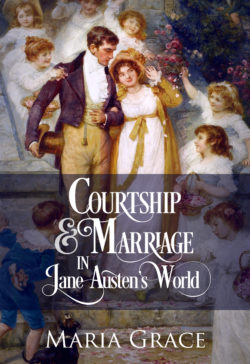The Wedding Ceremony in Jane Austen’s World
So you want to plan a regency era themed wedding ceremony> You might want to think about it a little more.

The Wedding Ceremony
Unlike weddings today, the regency era wedding ceremony was not widely attended events. Obviously the bride and groom, along with their witnesses, usually the bridesmaid and groomsman and the clergyman were there. Close family might be there and possibly local close friends, but that was all. No huge guest lists or full chapels to impress with a fancy wedding gown. Nice and simple for the bride, but rather a let down to anyone today who wants to have a regency-style wedding.
The bride named the day of the wedding, probably the only part of the prenuptial arrangements that was entirely under her control. Any day of the week was acceptable, though Sundays might be a bit inconvenient. Certain holy days, especially Lent were traditionally avoided. Somehow, it seems in keeping with the attitude of the times, that what she had control over was effectively the least significant part of the process. (Remember, as early as the fifteenth century, English ecclesiastical courts equated a promise to marry with a legal marriage, so the ceremony was, for many, secondary to the betrothal.)
Regency era wedding ceremonies were simple and entirely determined by the prescribed service in the Book of Common Prayer. Couples did not write their own vows or alter the service from what had been already established. (Yeah, I know, another disappointment, sorry. Don’t shoot me, I’m just the messenger.)
Brides, unless there was a special license involved, did not even get to pick the time for the wedding. All weddings took place between 8 AM and noon. Why?(Personally it sounds like a conspiracy by morning people, but that’s just me…) Experts of the day said: honorable people had nothing to fear in the light of day and people would be more serious in the morning. Obvious, right?
So, a morning wedding, few if any guests, read directly from the Book of Common Prayer–a little spartan, maybe we can dress t up with a few flowers? Nope, not much luck on that front either. Flowers, herbs or rushes might be scattered on the route or at the church porch, but that was about it.
There were the marriage lines though…

Marriage lines
After the ceremony, the clergyman, parish clerk, bride, groom, and two witnesses would proceed to the vestry to enter the ‘marriage lines’ into the parish register book. These ‘lines’ were explicitly set out in the Hardwicke Act and constituted the official record of the wedding, legal proof that it had taken place.
A copy of the records would be made and signed by all participants in the ceremony. The marriage lines would then be given to the new bride, notably her property, not the groom’s.
Why?
“Proof of her married state was much more important to a woman than to a man. Particularly among … the lower classes, a woman’s social standing, in some cases her very survival, depended upon her ability to prove she was a respectable married woman.
… A woman who was thought to be living with a man without benefit of clergy could be exposed to any number of dangers.
She could not depend on her husband for support if she could not prove she was his legal wife, … she might even be liable to arrest and incarceration as a prostitute. If she was a widow, she could be denied her lawful dower rights, even custody of her own children. … her ‘marriage lines’ were proof of one of the most important achievements of her life, and might be her best protection against life’s vicissitudes.” (Kane, 2008)
Definitely how a modern bride wants to wrap up her wedding!
Wedding Announcements
The newspaper announcement, in both a national and local newspaper was, arguably, the most socially important facet of the wedding. “Jane Austen once wrote, ‘The latter writes me word that Miss Blackford is married, but I have never seen it in the papers, and one may as well be single if the wedding is not to be in print.’” (Forsling, Weddings During the Regency)
Mrs. Bennet of Pride and Prejudice complains, “I suppose you have heard of it; indeed, you must have seen it in the papers. It was in the Times and the Courier, I know; though it was not put in as it ought to be. It was only said, ‘Lately, George Wickham Esq., to Miss Lydia Bennet,’ without there being a syllable said of her father, or the place where she lived, or anything. It was my brother Gardiner’s drawing up too, and I wonder how he came to make such an awkward business of it. Did you see it?”
Things could have been much worse than Mrs. Bennet complained, though. Sometimes the announcements did not even give the name of the bride, just her father’s name—and any titled connections, because who would dare forget them? Rather an ominous portend of the legal state of married life for women of the era.
To Read more articles on weddings, click here.
To read more articles on courtship click here.
To read more articles on marriage click here.
If you enjoyed this post, you might enjoy this book:

Comments
The Wedding Ceremony in Jane Austen’s World — No Comments
HTML tags allowed in your comment: <a href="" title=""> <abbr title=""> <acronym title=""> <b> <blockquote cite=""> <cite> <code> <del datetime=""> <em> <i> <q cite=""> <s> <strike> <strong>